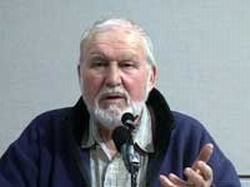More Questions on Alcan-Smelter Deal

Dr. Gordon Hartman has been examining all the talk about the "Alcan-new smelter-job loss-cold water release" discussions, and poses some new questions:
As usual, the river and the salmon get lost in the immediate, and loud, socio-economic debate. I wrote about this in an earlier article that was put out in OPINION 250 (see Fraser and Nechako Rivers Where Do We Want To Go?). However, here are some points again:
1) If all deals go through, Alcan will apparently get more water for power sale because with the cold water release, less water is required to meet temperature targets.
2) The Cheslatta Band will call for a certain flow through the Cheslatta - Murray Lakes system.
3) These two things will mean that Alcan will have to send down very cold water through the ’cold water release’ to meet a temperature target at the Nechako-Stuart confluence. However, if we are to judge by the past, this temperature target will be close to the upper limit for the sockeye in the Nechako at that point.
4) This will mean that the Nechako River, from the dam down, will have a very cold section, then it will warm up quickly where the Cheslatta-Murray flow comes in, then it will warm progressively more down to the confluence of the Stuart. Warming in this section will be rapid because the surface-to-volume ratio will be high in the wide Nechako River channel. The channel was shaped by a much larger river, so during the low flows (as already seen) it will be spread out, low and slow. These are good conditions for warming. This will also mean that the Nechako below the Stuart confluence will not be helped.
It may be that I do not have all details exactly correct. However, has anyone laid out a clear picture of the flow and temperature regimes that will occur in the river if Government-Alcan build a cold water release?
What will they be?
Will they be designed to provide a moderately increasing temperature gradient down-river, or will they maximize power generation?
What research and temperature-flow modelling has been done to guide the decision making and water allocation planning?
Has there been any research to determine how salmon and trout along the newly established temperature-flow gradient will distribute themselves?
Will fish stay in some reaches of the river and leave others?
Will growth rates of fish in the Nechako, above Cheslatta Falls be compromised?
Within a larger framework, has there been any thought given to using the cold-water release and flows through it as insurance against potential, future climate-change induced temperature increases in the Nechako to Prince George? We may well need ’wiggle room’ in regard to future temperature problems that could affect both Stuart sockeye runs as well as others (Sockeye and Chinook) through the Nechako.
I think that it is time to try to be forward-thinking about the whole Nechako and upper Fraser system. We have not been, so far. I am aware that there are people who will say ’the salmon aren’t worth it’, or that ’we are going to hell anyway, so why care?’.
All that I can say in reply, is that we should try to hold things together as long as we can.
Let us try, as much as possible to think beyond $$, us, and now.
G.F. Hartman
He has a Ph.D. in zoology, was the scientist in charge of a major fish-forestry research project, held senior positions in the provincial government and the Yukon government; He has taught at the university level for about six years (University of Guelph and Addis Ababa University) and spent three years in Africa with CIDA for two, and FAO for one. He thinks he has written about 80 publications, scientific, or managerial, or philosophical.
Previous Story - Next Story
Return to Home








